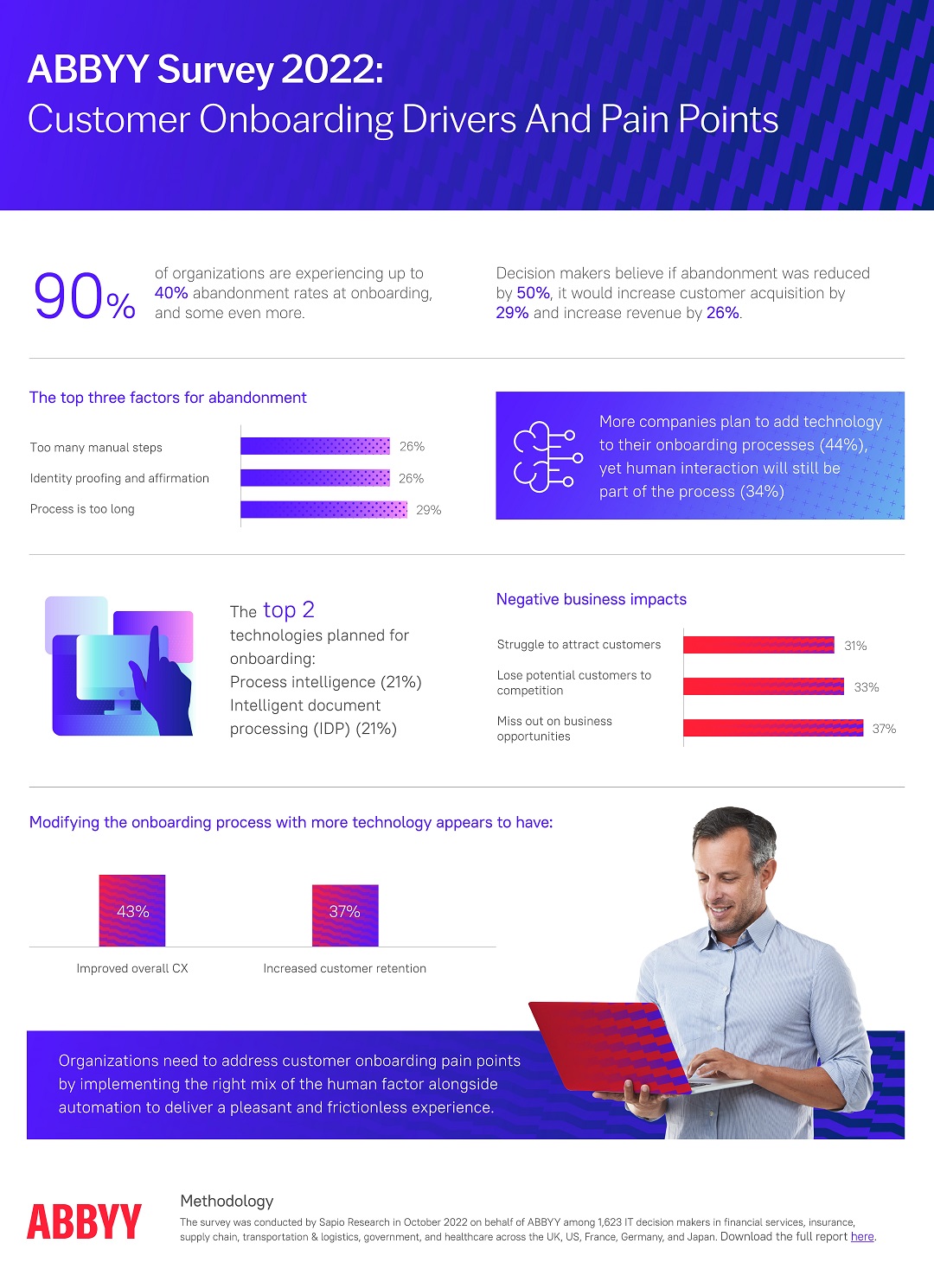90% of companies lose potential customers during the digital onboarding process, according to ABBYY State of Intelligent Automation Report Q4-2022


- Engagement and customer experience make up 52% of the reasons customers leave in the first 90 days
- Respondents believe if the abandonment rate was reduced by 50%, it would increase customer acquisition by 29% and increase revenue by 26%
- More than a third (34%) still plan to include human interaction during the digital onboarding process
A staggering nine-in-10 businesses experience some form of abandonment during the customer onboarding process with the banking sector experiencing the highest rate at almost 1-in-4 dropping out. However, simple measures like activating the right mix of human interaction alongside automation could resolve pain points, according to the global State of Intelligent Automation Report, Customer Onboarding Pain Points and Drivers Q4-2022 by Intelligent Automation company ABBYY.
Ineffective digital onboarding – when people sign up for an account or service online – can result in companies losing a prospect before they even become a customer, resulting in billions of lost revenues.
The factors contributing most to people dropping out during the onboarding process include:
- Almost a third (29%) of businesses say the biggest factor is the process is too long
- 26% say identity proofing and affirmation is a key pain point
- 26% say too many manual steps are to blame.
These have a direct impact on the bottom line with respondents stating that if the abandonment rate was reduced by 50%, it would increase customer acquisition by 29% and increase revenue by 26%.
The more time-consuming and complex an onboarding process appears, the higher risk of drop out. There are several issues that typically cause customers to churn during the onboarding process. Some of the most commonly cited complaints include:
- Missing a human element (24%)
- Customers repeating themselves (24%)
- Onboarding too slow (25%)
- Lack of communication (25%).
All of these issues have a significant impact on revenue with:
- Companies missing out on business opportunities (37%)
- Losing potential customers to competition (33%)
- Struggling to attract new customers (31%).

Solving the issue: The fine balance between technology and human interaction
Streamlining and modifying the onboarding process with technology appears to dramatically improve overall customer experience by up to 43% and increase customer retention by over a third (37%), according to the survey.
When it comes to choosing intelligent process automation tools, respondents said process intelligence (21%) and intelligent document processing (21%) are the top two measures that are being planned for onboarding by businesses across all industries. These technologies improve and monitor process workflows and accelerate the delivery of digitized documents via mobile devices, especially when needing to submit supportive documentation for proof of identity during the onboarding process.
Although changes to onboarding appear to be leaning towards adding technology to current processes (44%), it is evident that human interaction still plays a key role and is currently in place for onboarding for over a third of businesses (34%). Despite the rapid uptake of new technology since the pandemic, good customer experience is still about relationships, whether in person or online.
Businesses need to be mindful of how best to build and nurture customer relationships during the onboarding process – clearly the best kind of onboarding takes into account the fine balance between technology and human interaction.
Investing in the right mix of the two, alongside the correct tools for streamlining the process from proving identity to submitting supportive documents can have a dramatic impact on customer experience, which in turn significantly improves customer retention and therefore the bottom line.
Gabrielle Lukianchuk, Chief Marketing Officer at ABBYY
Get more insights into onboarding drivers and pain points and discover a better way to meet customer expectations in the new ABBYY State of Intelligent Automation Report by downloading here.
Methodology
This research was conducted by Sapio Research in September 2022 on behalf of ABBYY. The survey was conducted among 1,623 decision makers across the UK, US, France, Germany, and Japan on why onboarding processes need to change and what businesses need to do to address customer pain points – by activating the right mix of the human factor alongside automation.
About ABBYY
ABBYY powers intelligent automation. We reimagine the way people work and how companies accelerate business by delivering the intelligence that fuels automation platforms. Our solutions transform enterprise data and empower you with the insights you need to work smarter and faster.
We help more than 10,000 companies globally, including many of the Fortune 500, to drive significant impact where it matters most: customer experience, profitability, and competitive advantage.
ABBYY is a US-based global company with offices in 15 countries. For more information, visit www.abbyy.com/company/about-us/ and follow us on LinkedIn, Twitter and Facebook.
ABBYY can either be a registered trademark or a trademark and can also be a logo, a company name (or part of it), or part of a product name of ABBYY group companies and may not be used without consent of its respective owners.
Editorial Contact

